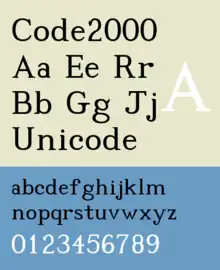Code2000
Code2000 is a serif and pan-Unicode digital font, which includes characters and symbols from a very large range of writing systems. As of the current final version 1.171 released in 2008, Code2000 is designed and implemented by James Kass to include as much of the Unicode 5.2 standard as practical (whereas 12.0 is the currently-released version), and to support OpenType digital typography features. Code2000 supports the Basic Multilingual Plane. Code2001 was a designed to support the Supplementary Multilingual Plane, with ISO 8859-1 characters shared with Code2000 for compatibility. A third font, Code2002, was left substantially unfinished and never officially released.
 | |
| Designer(s) | James Kass |
|---|---|
| Date released | 2008, v1.171 RTM |
| Designer(s) | James Kass |
|---|---|
| Date released | 2008, v0.919β |
| Designer(s) | James Kass |
|---|---|
| Date released | 2005, v0.917β |
Code2000 was released as shareware/donationware, with the licensing fee set at $5.00. Code2001 was released under a free software license that prohibited most derivative works but otherwise allowed free use, redistribution and embedding. The project was abandoned in 2008, with its web domain name later taken by an Australian programming site.[1]
Code2000
The names in the following list are taken directly from the Unicode standard.
|
It also includes several scripts not officially recognized, in the Unicode Private Use Areas:
Code2001
This is a second font in the Code 2000 family. It covers the Unicode Plane One Supplementary Multilingual Plane, mostly used for historic language scripts. The majority of these glyphs are not found in Code 2000.
Code2001 includes support for:
- ISO-8859-1 characters
- Linear B
- Aegean numbers
- Phaistos
- Old Italic
- Gothic
- Ugaritic
- Old Persian Cuneiform
- Deseret
- Shavian script
- Osmanya
- Cypriot syllabary
- Phoenician
- Byzantine Musical Symbols
- Musical Symbols
- Tài Xuán Jīng Symbols
- Counting Rod Numerals
- Mathematical Alphanumeric Symbols (including the ones in the Letter-like Symbols block)
- Domino Tiles
As the font ceased updating in 2008, it does not include the emoji, added to Unicode in version 6.0, that make up the best-known and most commonly used characters in the set. This font covers a few characters in the Unicode Plane Two Supplementary Ideographic Plane. It also covers a few tags in Unicode Plane Fourteen Supplementary Special-purpose Plane.
Also included are:
The first two are not yet approved for use in Unicode, and therefore are encoded in the Plane Fifteen Private Use Area and the Basic Multilingual Plane. (As noted above, the former two are also available in Code2000.) The Pollard Script is in Unicode now, so its spot is deprecated.
Code2002
This is a third font in the Code 2000 family. The glyphs in this font are not part of either Code 2000 or Code 2001.
This font partially covers the Unicode Plane Two Supplementary Ideographic Plane. This is a Supplementary Plane used for Chinese, Japanese, and Korean ideographs. Roughly 40% of Plane Two is included in this font.
See also
Other well-known Unicode fonts include:
References
- "Last archive copy of James Kass' website". Archived from the original on January 8, 2011. Retrieved December 26, 2011.
{{cite web}}: CS1 maint: bot: original URL status unknown (link)